26th October 2022
A day in the life of the Care Coordinators
There’s one team at the hospice you don’t hear a lot about, but they work flat out behind the scenes, handling calls from 6.30 am till 10.30 pm to ensure the hospice provides care to those who need it most.

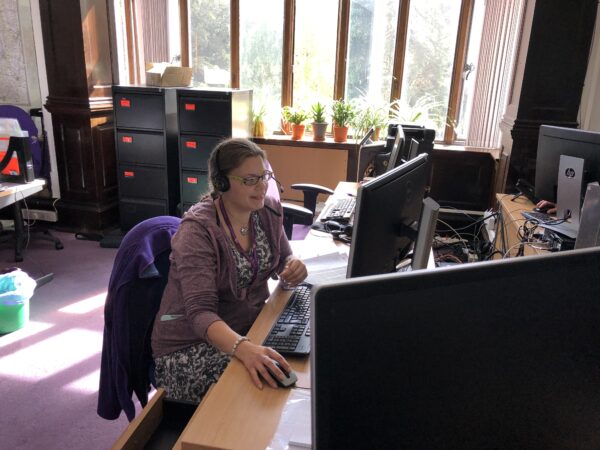
Sometimes described as the ‘beating heart’ of the hospice, our Care Coordination team is crucial to the smooth running of the organisation. We spent a day with the team to get an inside look at what goes on…
6.30 am
Handover takes place between the Hospice at Home care coordinator and the Hospice Night Support Team.
Phones divert from the Night Support team to the duty Coordinator and today it’s Molly on duty. She picks up on any urgent issues that have arisen with patients overnight.
This might include a patient’s condition deteriorating so they need urgent care, a crisis in the home, referral to their GP or a patient dying. Hospice at Home staff on shift overnight in patient’s homes also check in with Molly when they finish their shift.
8:00 am
Molly arrives at the office ready for the handover with our Hospice Outreach and Discharge Support (HODS) team, who will be out seeing patients today. They discuss anything that’s come up overnight and run through the day’s visits.
Molly then reviews notes received from overnight Hospice at Home staff and updates System One so District Nursing staff and other relevant NHS teams involved in a patient’s care can access up to date information.
Two new referrals have come in overnight. One is a patient who has pet snakes, so the team need to take this into consideration when allocating a staff member to go. Pets are important to patients and families and our teams will strive to deliver care in community settings. Risk assessments are undertaken to ensure that staff and patients are safe during visits.
8.15 am
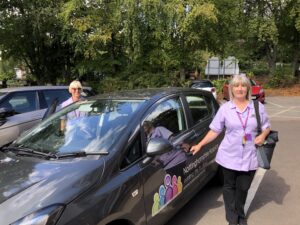
The HODS team head off for their morning visits. Today it’s Wendy and Kate on duty and they have four patients to visit this morning.
8.30 am
Coordinator Stuart arrives to start his shift and the phone starts to ring. It’s a busy office and as well as Care related calls, the team picks up calls for other areas of the hospice.
The care coordinators take referrals and work out which staff – registered nurses and healthcare assistants – to send where and reassuring family members. They are often the first port of call for distressed relatives.
Staff experience and skills are taken into consideration prior to allocating patients to ensure that patients with complex needs are seen by our Registered Nurses where possible.
9.00 am
we catch up with Molly to learn more about her role. She’s been at the hospice since March, before which she worked in an NHS community nursing team.
Molly says: “We are the front line of the hospice. We’re often the first people to speak to relatives worried about their loved ones.
“It’s rewarding helping families in the hardest times and making sure patients who are reaching end-of-life are getting the good support from the hospice.
“Each day is different. No phone call is the same. Each call we take, we learn something new. We have a good strong team here and I enjoy the role.”
10.00 am
The team continue to take calls. These might be new referrals from NHS colleagues, self-referrals from patients or their relatives, or queries regarding care we’re already providing.
When taking a new referral, they run through an assessment check-list about the patient including diagnosis, prognosis, medication, what equipment they have in the home e.g. a hospital bed, are they on oxygen, and whether there are any smokers or pets in the property.
This assessment helps them coordinate care and decide who to send where.
Patients are categorised according to the Gold Standards Framework which uses a traffic light system to assess end-of-life patients’ needs. Red means likely to die imminently, amber in the next few weeks and green in the next six months. The team uses this system to prioritise care to those in most need.
11.00 am
Stuart contacts Hospice at Home nurses to advise them where they’re going tonight. If they’ve worked a night shift last night they’ll still be sleeping, so he texts them so they can call back later.
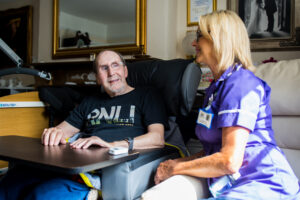
Stuart says: “We can’t plan too far in advance because things change so frequently. A patient’s condition might deteriorate so their need becomes more urgent. If a patient we’re due to visit dies, we then need to reallocate that care.
“We all work together well as a team which is so important as we need to have a complete understanding of our patients.”
He says the hospice is in a unique position in being able to spend time with patients and support their families.
“Having our staff member in a patient’s home for a nine-hour shift gives us the opportunity to talk with family members about end of life. Effectively it’s pre-bereavement support. We have the luxury of spending time with a family where we can offer support. Our staff are all experienced in delivering end of life care which gives the family confidence.”
12.00 pm
The HODS team return from their morning visits and update on any issues, before going out again in the afternoon.
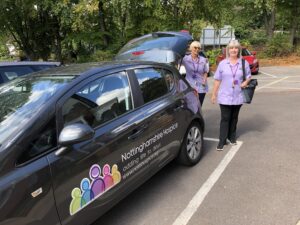
12.30 pm
Hospice at Home Lead Nurse Jenny is planning rotas for the team. Jenny manages the work of the team and oversees the caseload. She is the registered nurse lead so the team can refer to her if they need advice.
1.00 pm
A referral’s come in from the NHS Fast Track team about a patient who’s deteriorated. They’ve asked if the hospice can get involved and provide a care package. The team looks at rotas to see if they can get anyone in for tonight or tomorrow.
Good coordination and planning are crucial for the care coordinators, as is flexibility. As the situation with patients constantly changes, plans need to be adapted frequently.
2.00 pm
After a slight lull, the phones get busy again as Hospice at Home staff call in for their instructions for tonight.
If a nurse is going to a new patient, the coordinators give detailed information about what to expect when they get there, including directions of how to get to the property – particularly important in rural areas where SatNav can be less reliable.
2.30 pm
Coordinator Kathryn arrives for the late shift.
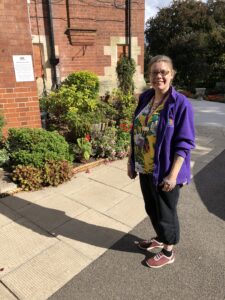
Kathryn came to work at the hospice two years ago on the HODS team, working in patients’ homes before joining the coordinators team in July.
She says “Having worked face-to-face with patients in their homes, it helps you relate to the patients and the staff you are liaising with in the role.
“I’m proud to work here. It’s really good to know the support you put in is helping people who are often on their knees when they ring us. We are a lifeline. You hear relief in their voices on the phone.”
3.00 pm
Molly takes a call from a family member who has concerns about care provided last night. The team check the records which show the hospice didn’t provide care for this particular patient. After further information gathering it transpires that the patient also has two care agencies involved in their care, so we are able to reassure the relative and advise them where to go with their query.
Often patients at end of life have multiple agencies involved in their care. This can include District Nurses, Clinical Nurse Specialistsand private care agencies as well as the hospice. This can be confusing, particularly for elderly relatives. Once Nottinghamshire Hospice gets involved, our staff member at the property can take the time to explain to relatives what each agency does.
4.30 pm
The phones divert to the duty mobile, but the day isn’t over for Kathryn. She’s on duty till 10:30 pm when she’ll check in with all the Hospice at Home staff to make sure they are safely in their properties.
5.00 pm
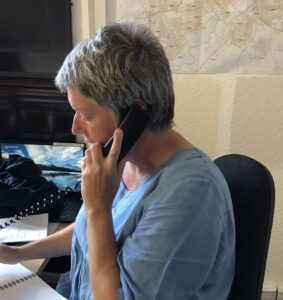
We catch up with Jenny at the end of the day. Although the phones have rung a lot, she says it’s been a relatively quiet day.
“Our coordinators work very hard and we’re proud of the contribution they make to the smooth running of the hospice. As ‘back office support’ to the day to day care provided it’s good to shine a light on what they do.”
